While the reverse osmosis system is the safest way to remove unwanted particles in your water system, it takes time to complete the process. Thus, it is imperative to pick the best reverse osmosis system to make the wait worthwhile.
A good system needs clean, durable pre-filters and post-filters for the water to pass through. It should also have a high-grade RO membrane, plus reliable parts, including the cold water valve, shut-off valve, and a big enough storage tank.
- iSpring 5-Stage RCC7 Reverse Osmosis System
- APEC Water Systems ROES-50-A Reverse Osmosis System
- APEC Water Systems RO-90 Reverse Osmosis System
- Home Master TMAFC-ERP Reverse Osmosis System
- Home Master TMAFC Reverse Osmosis System
- Tier1 RO5 Reverse Osmosis System
- Express Water RO5DX Reverse Osmosis System
- iSpring RCC7AK Reverse Osmosis System
- Hydro-Logic 31035 Reverse Osmosis System
- Global Water 5-stage Reverse Osmosis System
Reverse Osmosis System Reviews
iSpring 5-Stage RCC7 Reverse Osmosis System

iSpring RCC7 is capable of rejecting 99% of more than a thousand pollutants in water. It eliminates impurities through its 5-stage filtration system, and features a European style faucet made of brushed nickel, and transparent housing to monitor the filtration with ease.
>>>> Click Here To See Customer Reviews & Current Price <<<<
APEC Water Systems ROES-50-A Reverse Osmosis System
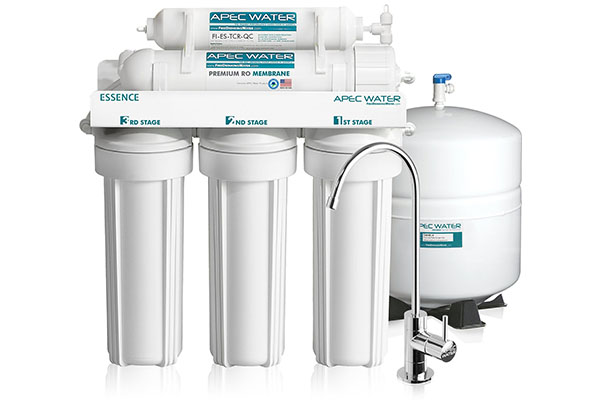
APEC ROES-50-A can remove 99% harmful contaminants, like lead, heavy metals, chlorine and arsenic in water. It features durable filters designed to treat and purify water, quick connector fittings and high pressure faucet. Its storage tank is NSF certified.
>>>> Click Here To See Customer Reviews & Current Price <<<<
APEC Water Systems RO-90 Reverse Osmosis System

APEC RO-90 can provide refreshing and crisp taste to water. It has high performing and long-lasting filters. It filters water in five stages, and features NSF certified parts and JG quick fit ConnectFittings without the need for extra locks and fittings.
>>>> Click Here To See Customer Reviews & Current Price <<<<
Home Master TMAFC-ERP Reverse Osmosis System

Home Master TMAFC-ERP is capable of re-mineralizing water twice. It can purify water in 7 stages, completely removing all harmful contaminants. It also has a more advanced design, auto shut-off mechanism, stress-free and long-lasting filters and fast flow rate.
>>>> Click Here To See Customer Reviews & Current Price <<<<
Home Master TMAFC Reverse Osmosis System
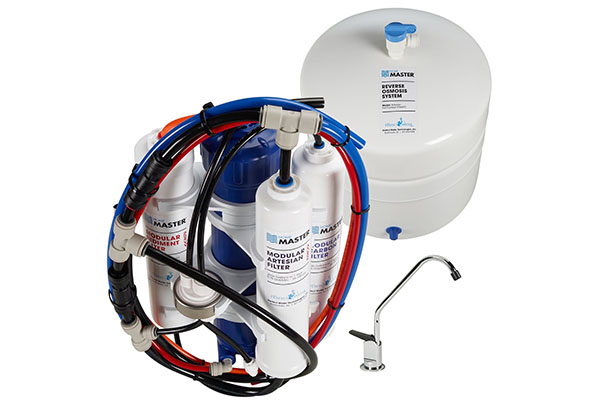
Home Master TMAFC can purify around 50 gallons of water per day through its 7-stage filtration system. It utilizes a patented artesian full contact technology designed to restore minerals in water. It has a chrome RO faucet, storage tank, advanced modular filters and large fittings and tubing.
>>>> Click Here To See Customer Reviews & Current Price <<<<
Tier1 RO5 Reverse Osmosis System
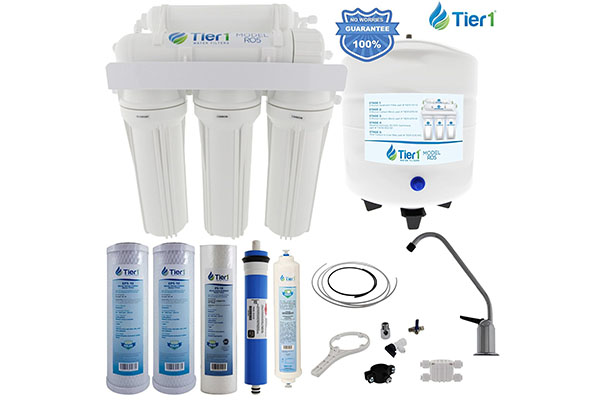
Tier1 RO5 uses five stages to produce around 50 gallons of filtered water every day. It has almost everything you need for this system, including starting filters, saddle valves, shut-off valve, fittings, tubing, brackets and membranes. It gets rid of harmful contaminants in wall and city water.
>>>> Click Here To See Customer Reviews & Current Price <<<<
Express Water RO5DX Reverse Osmosis System
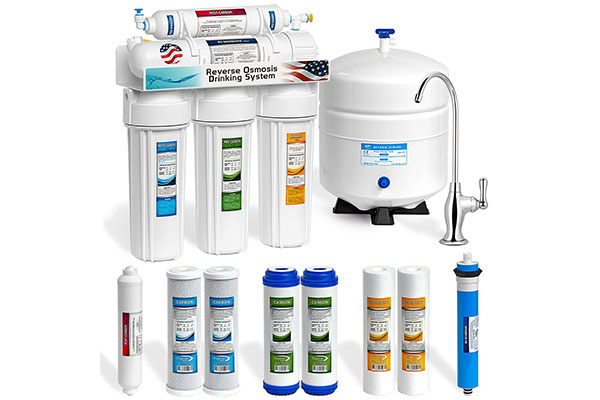
With Express Water RO5DX, water is not only purified, but also tastes good and fresh. It uses a 5-stage RO filtration system designed to remove 99% of contaminants and impurities in ground or tap water. It has NSF certified steel storage tank, reverse osmosis membrane, and auto shut-off valve.
>>>> Click Here To See Customer Reviews & Current Price <<<<
iSpring RCC7AK Reverse Osmosis System
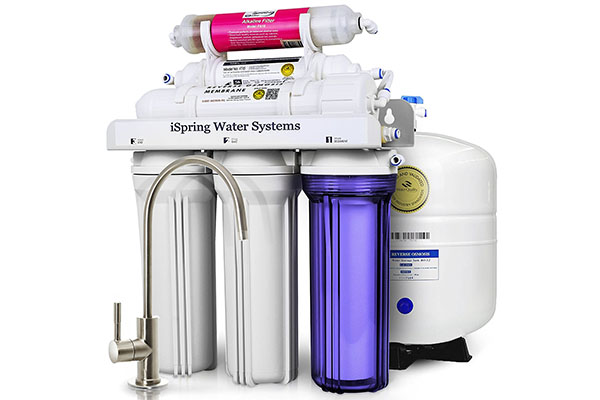
With its 6-stage filtration system, users can expect to receive healthy and safe water from iSpring RCC7AK. It features a durable construction, RO membrane, which aids in restoring lost minerals and sturdy filters. It also operates without noise and hassle.
>>>> Click Here To See Customer Reviews & Current Price <<<<
Hydro-Logic 31035 Reverse Osmosis System
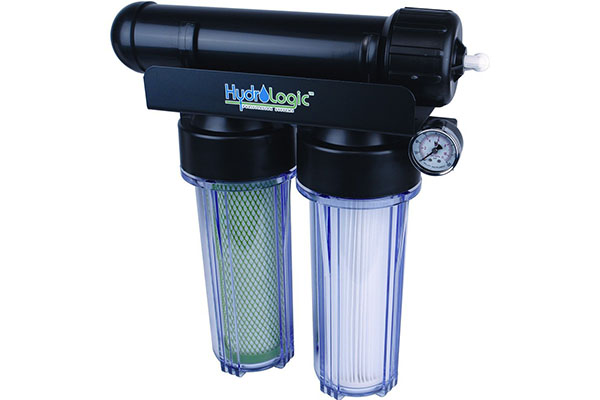
Ideal for indoor gardeners, Hydro-Logic 31305 is a compact reverse osmosis system designed to provide you, as well as your plants with high quality water. It uses a semi-permeable RO membrane, garden hose connection, reusable sediment filter and eco-friendly carbon filter. It can remove 98% contaminants and chlorine.
>>>> Click Here To See Customer Reviews & Current Price <<<<
Global Water 5-stage Reverse Osmosis System
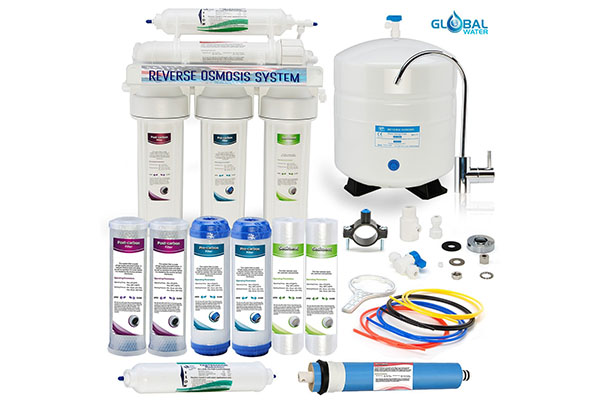
This RO system from Global Water uses a high-performance 5-stage filtration process to produce purified, healthy and great-tasting water. It has quick-connect fittings and premium NSF filters. It also features NSF certified and lead-free tank and faucet.
>>> Click Here To See Customer Reviews & Current Price <<<<
Types Of Reverse Osmosis Systems
Each type of Reverse Osmosis system will require different sets of membranes. These membranes are its filters, and each will block out different kinds of contaminants and impurities.
Floor Types: Water will go through nine filters in this type, making the quality of its output unquestionable. Such a process, however, took a toll on its production rate. An hour will more or less produce a gallon of water.
Floor types are best suited for facilities requiring utterly clean water such as laboratories, hospitals and clinics.
Counter-top Models: These types are what is recommended for home and office use. It can produce one and a half gallons of clean water per hour and makes use of four to nine filters.
POU (Point of Use) Reverse Osmosis Systems: This type of system is commonly installed under the sink to provide continuous supply of clean water through the tap.
Apart from the membranes, this system is equipped with carbon filters to better block out impurities and contaminants. And unlike with the rest, the POU RO system does not make use of storage.
How To Select a Reverse Osmosis System
Reverse osmosis is considerably more expensive than other filtration systems because it produces more waste water. Being wise with your choice could save you a lot, and below are the important things to take note of.
How much clean water do you need per day? GPD or gallons per day produced is a factor that will come into question. You need to ask yourself if clean water shall be for drinking purposes only or not.
Also, you need to determine how many people will share the clean water. Overestimations lead to more wastage, so always stay within your daily range.
Where will the system be installed? Different facilities will have varied requirements. Space and location, after all, are issues many people forget to consider when buying reverse osmosis systems.
Determining this will lead you to realize what limitations your systems should have. For example; Should it be portable? Are tankless systems more ideal? And etc.
What Types of Contaminants and Impurities does Your Water Have? Regular systems have four to five filters, each blocking specific elements in the water. If your water, for example, is free of organic contaminants, then a filter for that should be unnecessary.
Hard water, unfortunately, isn’t perfectly compatible with reverse osmosis. Installing a separate water softener system, although not required, can help lengthen the life of the RO system.
How To Maintain Your Reverse Osmosis System
Compared to other filtration systems, reverse osmosis requires more attention to schedule and details. Because apart from weakening the water pressure, the water will start to taste weird if anything isn’t done as advised.
First off, know that there are will be three sets of filter change and cleaning; the bi-annual system maintenance, the annual maintenance, and the membrane maintenance.
Every six months, the sediment and carbon block filters would need to be changed. Of course, before putting new filters in, the housing should be cleaned with a mild soap solution.
The annual maintenance will include changing the final polishing filter, cleaning with a common household bleach, and checking the storage tank’s air pressure. These tasks go on top of the bi-annual maintenance rituals.
Membranes are the life and blood of reverse osmosis systems. Thankfully, maintenance happens only between two to five years, depending on the condition of the water and how much the system is being used.
To make sure the system is performing satisfactorily, have its product water tested for total dissolved solids (TDS), or the amount of salts, minerals and metals dissolved in the water.
How Reverse Osmosis Systems Work
Reverse osmosis filtration systems have five major stages that doesn’t differ much from other systems. Most manufacturers, however, offer two optional filtration stages to better address the needs of your water.
The first two entails the removal of large particles such as rust and sand, and of chemical contents such as chlorine and chloramine.
These contaminants have the potential to damage the membrane, hence their importance. In fact, additional layers of carbon filters could be installed once deemed necessary.
The third stage is the reverse osmosis stage. Osmotic pressure is used to push tap water through the fine fibers of the membrane. The process causes pure water to leave behind its impurities, giving users both clean and contaminated water.
The resulting clean water is pure H2O, which is, unfortunately, acidic. To balance its pH, the fourth stage of the filtration process will remineralize the water with calcium and magnesium.
As for the final stage, the water would either be deposited in the storage tank, or processed under a UV filter to eliminate remaining microorganisms, and a polishing filter.